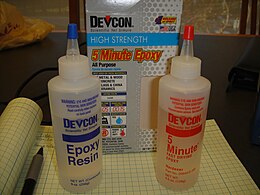| This article does not cite any sources. Please help improve this article by adding citations to reliable sources. Unsourced material may be challenged and removed. Find sources: "Epoxy glazing" – news · newspapers · books · scholar · JSTOR (December 2021) (Learn how and when to remove this message) |
Ceramic fixtures are being more commonly glazed with 2 part epoxy compounds. The first component is a clear or opaque resin combined with a catalyst or hardener. The proper procedure requires that the nonporous fixture be sand blasted to create a rough surface for the epoxy primer to adhere to. Once the primer has dried the topcoat is applied. Since a true epoxy begins to yellow at the age of 1 year acrylic polyurethane compound is used in the topcoat. This resin is also catalyzed with a hardener and can last up to 15 years or more with proper maintenance.
Formica countertops can also be glazed in this fashion using a faux stone or granite look.
